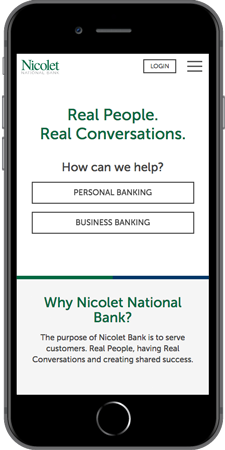If you’re like most businesses, your website caters to different target markets. Whether it’s new users, returning customers, employees, or job seekers, each group should feel that you are catering to their specific needs. Rather than having a one-size-fits-all website, segmenting your site by audience type is a great way to maintain consistent branding that accommodates all site visitors.
 What is Audience Segmentation?
What is Audience Segmentation?
Audience segmentation involves gaining a deep-rooted understanding of each of your target audiences, figuring out how they interact with your brand, and then utilizing this information to create a more focused and engaging online experience for each individual group. This segmentation allows users to direct themselves to specific subpages, often resembling microsites, which can contain custom messaging, navigation and layout designs for each subdivision. This segmented structure allows for a more engaging experience for web users, which in turn can lead to more conversions.
Best Practices
Make it easy for users to get where they’re supposed to be:
Audience segmentation is pointless if there is any confusion as to how to get to the designated sections. Clear titles, descriptions, and images that will resonate with the differentiated audiences are necessary in order to produce results.
Conduct extensive research on each segment:
Before you can get to work designing layouts and creating content for each subsection of your website, research needs to be conducted on how each audience segment interacts with your site. Understanding how they are getting to your website, how much time they are spending on certain aspects of your current site, and their overall preferences will help you gain a deeper perspective on your audiences. This research can not only help you optimize your website, but also give you insights on how to go about other digital ventures such as email campaigns and social media marketing. Resources that can help with finding this data include Google Analytics, Adobe Analytics, or another established website traffic tool.
Set conversion goals:
What actions are you hoping for each specific audience to complete on these subpages? Setting clear conversion goals will help you create content, calls to actions, and overall messaging for your sub sections. These conversion goals can include newsletter sign ups, purchases, form submissions, and more.
Challenges
While audience segmentation is a great method of engaging all visitors on your website, it’s important to keep in mind the challenges that can arise. First and foremost, making the move to a fully segmented website requires a lot of content, research and resources, which can be straining for small to midsize businesses. Additionally, audience segmentation doesn’t work for all websites. Some businesses have a very focused audience range and list of services. Therefore, a standard web structure may be best.
Are you looking to structure your website in a way that caters to each of your audience segments, but don’t have the time or resources to do so? Contact Starkmedia today and learn more about how you can increase online conversions through a segmented website structure.